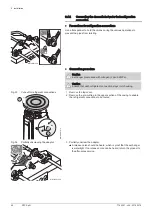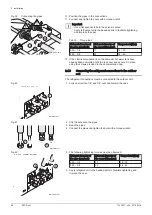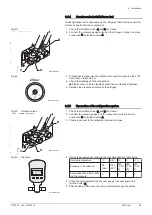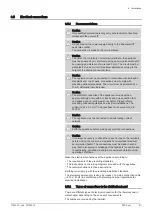
6.4.4
Carrying out a leak-tightness test
A leak-tightness test is necessary as the refrigerant fluid can have harmful
effects on health and the environment.
1. Check that isolation valves A and B are closed.
2. Connect the pressure gauge valve and the nitrogen cylinder to service
connection C on isolation valve A.
3. Progressively pressurise the refrigerant connection pipes in steps of 5
bar until you reach 25 bar.
4. Check the tightness of the connections.
If leaks occur, redo the leaking connection and recheck tightness.
5. Release the pressure and release the nitrogen.
6.4.5
Evacuation of the refrigeration system
1. Check that isolation valves A and B are closed.
2. Connect the vacuum gauge and the vacuum pump to the service
connection C on isolation valve A.
3. Create a vacuum in the refrigerant connection pipes.
4. Check the pressure according to the recommendations table below:
Outside temperature
°C
≥ 20
10
0
- 10
Pressure to be reached
Pa
(bar)
1000
(0.01)
600
(0.00
6)
250
(0.00
25)
200
(0.00
2)
Evacuation time after reach
ing the pressure
h
1
1
2
3
5. Close the valve between the vacuum gauge / vacuum pump and
isolation valve A.
6. After shutting off the vacuum pump, immediately open the valves.
Fig.43
B
A
C
MW-4000143-1
Fig.44
25 bar
MW-4000144-2
Fig.45
Isolation valves
B
A
C
MW-4000145-1
Fig.46
Pressure
MW-4000146-1
6 Installation
7740321 - v04 - 03122019
SPC Split
49
















































